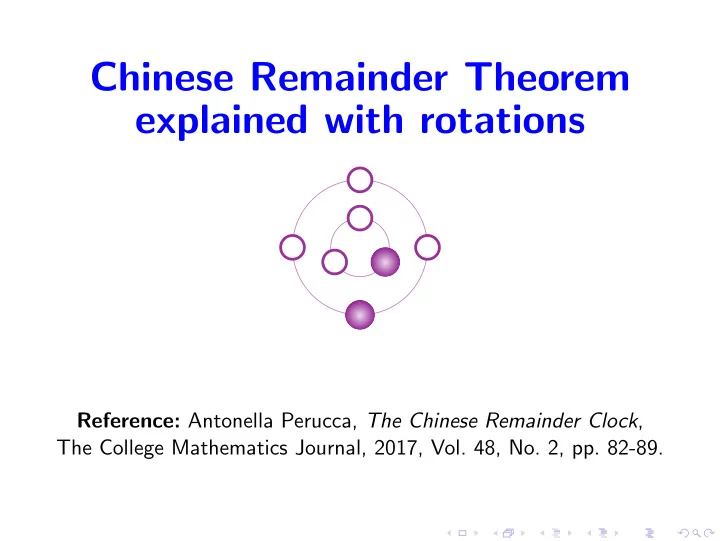

Chinese Remainder Theorem explained with rotations Reference: Antonella Perucca, The Chinese Remainder Clock , The College Mathematics Journal, 2017, Vol. 48, No. 2, pp. 82-89.
One step-wise rotation Consider a circle with one marked point on it. ◮ Fix some positive integer m . At every time unit, let the point move 1 m -th of the circle clockwise. ◮ This phenomenon is periodic, the fundamental period is m . ◮ We identify the positions with the integers from 0 to m − 1. For convenience, we set the initial position and 0 at the top. Example: m = 3, the position at time 0 0 2 1 2
Two simultaneous rotations Consider two simultaneous rotations with m 1 and m 2 steps. ◮ There are m 1 · m 2 configurations for the pair of points. Example: m 1 = 3 and m 2 = 4, the configuration at time 1 0 0 3 1 2 1 2 3
Impossible configurations Consider two simultaneous rotations with m 1 and m 2 steps. ◮ In general, not all of configurations occur because the rotations are simultaneous (this is evident if m 1 = m 2 ). Example: m 1 = 4 and m 2 = 6, the configuration at time 7 and an impossible configuration 4
Fundamental period for two rotations ◮ The fundamental period is the least common multiple of the single periods. Indeed, the fundamental period is the smallest positive time at which both points are back to the initial position, namely the least common multiple of m 1 and m 2 . ◮ Each configuration occurs at most once in every fundamental period (because getting the same configuration implies that both points did full turns). We deduce: ◮ The fundamental period is the number of occurring configurations. ◮ Special case m 1 and m 2 coprime: The fundamental period is m 1 · m 2 , every configuration occurs. 5
Generalisation to several rotations Consider simultaneous rotations with m 1 , m 2 . . . , m n steps. ◮ The fundamental period is the least common multiple of the single periods. Namely, the least common multiple of m 1 , m 2 . . . , m n . ◮ Each configuration occurs at most once in every fundamental period. ◮ The fundamental period is the number of occurring configurations. ◮ Special case m 1 , m 2 . . . , m n pairwise coprime: The fundamental period is the product m 1 · · · m n , every configuration occurs. 6
CRT for rotations We have thus proven: Chinese Remainder Theorem for rotations Let m 1 , · · · , m n be pairwise coprime positive integers. For each in- teger m in this set, consider a circle with one marked point on it, 1 which at every time unit rotates of m -th of the circle clockwise. The fundamental period for this phenomenon is m 1 · · · m n , and eve- ry configuration for the n -tuple of marked points occurs exactly once in the fundamental period. Remark: Even if the integer parameters are not coprime, the configuration of the marked points determines the time inside a fundamental period because it occurs at most once. 7
CRT for cyclic periodic phenomena Consider a cyclic periodic phenomenon, where finitely many distinct situations repeat cyclically. This can be seen as a rotation with as many steps as the fundamental period, so we have proven: Chinese Remainder Theorem for cyclic periodic phenomena If m 1 , · · · , m n are pairwise coprime positive integers, then a cyclic periodic phenomenon with fundamental period m 1 · · · m n amounts to the collection of simultaneous cyclic periodic phenomena whose fundamental periods are m 1 to m n . Corollary: A cyclic periodic phenomenon with fundamental period m can be described by cyclic periodic phenomena whose fundamental periods are the prime powers appearing in the factorization of m . 8
CRT for lists of remainders Chinese Remainder Theorem for lists of remainders Let m 1 , · · · , m n be pairwise coprime positive integers. For every in- teger consider the n-tuple of its remainders after division by m 1 to m n . We then have: ◮ Two integers produce the same n-tuple if and only if they leave the same remainder after division by the product m 1 · · · m n . ◮ All n -tuples consisting of remainders after division by m 1 to m n are produced. Proof: The result can be deduced from the CRT for rotations. A list of remainders can be identified (in an obvious way) with a configuration of marked points. � 9
The usual CRT Chinese Remainder Theorem Let m 1 , · · · , m n be pairwise coprime positive integers. An integer in the range from 0 to m 1 · · · m n − 1 is uniquely determined by the n -tuple of its remainders after division by m 1 to m n . Proof: This is a reformulation of the previous result. � 10
Generalisation of the usual CRT Generalized Chinese Remainder Theorem Let m 1 , · · · , m n be positive integers. An integer in the range from 0 to lcm ( m 1 , . . . m n ) − 1 is uniquely determined by the n -tuple of its remainders after division by m 1 to m n . Proof: The result can be deduced from the corresponding result about simultaneous step-wise rotations. � Remark that an impossible n -tuple of remainders corresponds to an impossible configuration for the n -tuple of marked points. 11
Thank you for your attention! 12
Recommend
More recommend